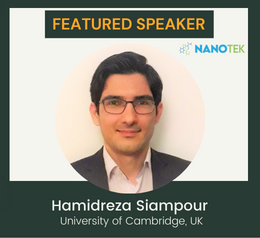Scholars Frontiers in
Nanoscience and Nanotechnology Congress
THEME: "Fostering Advancements in Nanoscience and Nanotechnology"
 27-28 Mar 2023
27-28 Mar 2023  Crowne Plaza Ealing, London, UK & Online
Crowne Plaza Ealing, London, UK & Online THEME: "Fostering Advancements in Nanoscience and Nanotechnology"
 27-28 Mar 2023
27-28 Mar 2023  Crowne Plaza Ealing, London, UK & Online
Crowne Plaza Ealing, London, UK & Online 
University of Cambridge, UK
Title: Hybrid quantum photonics with nanodiamonds and plasmons
Dr. Hamidreza Siampour is a
Research Associate at the University of Cambridge working on diamond-based
quantum nano-sensors. He received a PhD degree in Nano-optics from the
University of Southern Denmark for his thesis "A Nanophotonic Platform for
Quantum Optical Integrated Circuits". From Jun-2019 to Jan-2022, he was a
postdoc at the University of Sheffield working on the development of a semiconductor
nanophotonic platform for directional spin-photon coupling. As
a Visiting Researcher at Ulm University (07/2018-09/2018), he investigated GeV
centers in nanodiamonds coupled to plasmonic waveguides. Before that, he was
working on the project of single-atom electronics at Shanghai Jiao Tong
University (2013-2016) where he proposed and developed the idea of Si nanowire
core-shell phototransistors based on two-photon-absorption phenomena at telecom
wavelengths. From 2009 to 2013 he was a Research Assistant at Isfahan
University of Technology, where he developed a sequential quadratic programming
algorithm for solving inverse scattering problems based on non-radiating
current reconstruction.
Hybrid quantum photonic
platforms combining different photonic elements in a single functional unit
have great potential to leverage the strengths of individual subunits while
avoiding their respective limitations. The desired functionality of such a hybrid
integration relies on strong light-matter interaction at the single-photon level, and requires
nanometre-scale fabrication precision and potentially involves a material
diversity that is incompatible with standard nanotechnological processes. In
this talk, I will discuss our developments in realization of hybrid integrated
quantum photonic circuits based on dielectric-loaded plasmonic waveguides,
containing accurately positioned nanodiamonds (NDs) with colour centres. This
includes a top-down fabrication technique that was developed for accurate and
deterministic positioning of waveguide components to incorporate NDs containing
a single (nitrogen, silicon or germanium) vacancy centre1. Moreover, a
chip-integrated cavity was demonstrated combining resonant and plasmonic
enhancement to increase the spontaneous emission rate of single photons with up
to 42-fold at the cavity resonance2. We have also demonstrated
on-chip remote excitation of single quantum emitters by the plasmonic modes in
dielectric ridges atop colloidal silver crystals3. Quantum emitters were
produced by incorporating single germanium-vacancy (GeV) centres in NDs,
providing bright, spectrally narrow and stable single-photon sources suitable
for highly integrated circuits. Cryogenic characterization of GeV-NDs indicated
symmetry-protected and bright zero-phonon optical transitions with up to 6-fold
enhancement in energy splitting of their ground states as compared to that
found for GeV centers in bulk diamonds (i.e. up to 870 GHz in highly strained
NDs vs. 150 GHz in bulk)4.